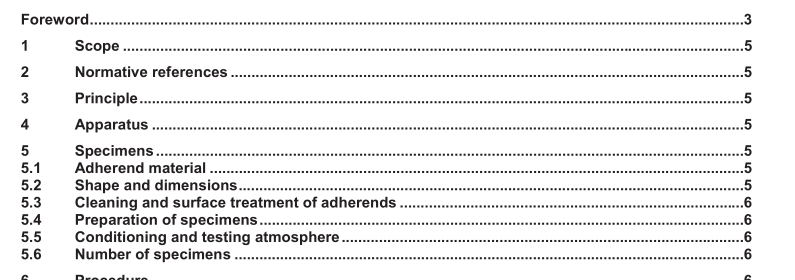EN 15336:2007 – Adhesives – Determination of the time to rupture of bonded joints under static load ( ISO 1 51 09:1 998 modified)

1 Scope
This European Standard describes a procedure for the determination of the time to failure of a bonded joint,using a specimen which is statically loaded under specified conditions. This method can only be used for comparing adhesives, and the results cannot be used for design purposes.
2 Normative references
The following referenced documents are indispensable for the application of this document. For dated references, only the edition cited applies. For undated references, the latest edition of the referenced document (including any amendments) applies.
EN 1465, Adhesives — Determination of tensile lap-shear strength of rigid-to-rigid bonded assemblies (ISO 4587:1979 modified)
EN 13887, Structural adhesives — Guidelines for surface preparation of metals and plastics prior to adhesive bonding
EN ISO 291, Plastics — Standard atmospheres for conditioning and testing (ISO 291:2005)
EN ISO 10365, Adhesives — Designation of main failure patterns (ISO 10365:1992)
3 Principle
The time to rupture of a bonded lap-shear specimen is measured under a specific load.
4 Apparatus
4.1 Test rig, capable of holding specimens securely at one end, in the vertical position, the other end of each specimen being linked to a fixture capable of receiving different weights in order to vary the load. The direction of the load shall coincide with the longitudinal axis of the specimen. The rig shall be capable of loading several specimens simultaneously. It shall be designed such that any vibration associated with breakage of one specimen will not influence the remaining specimens. The rig shall be placed in an environmentally controlled cabinet or be designed such that the specimens are tested under controlled conditions.
4.2 Timer, capable of measuring the time to failure of a specimen to an accuracy of ± 1 %.
5 Specimens
5.1 Adherend material
The adherends shall be made of metal, rigid plastic or rigid fibre-reinforced plastic.
5.2 Shape and dimensions
Specimens shall be as shown in Figure 1. The thickness of the adherends shall be sufficient to avoid significant plastic deformation.
5.3 Cleaning and surface treatment of adherends The cleaning and surface treatment of adherends shall be in accordance with the instructions of the adherend manufacturer and/or adhesive manufacturer, and/or shall be chosen from the methods described in EN 13887.
5.4 Preparation of specimens Prepare specimens in accordance with the procedure described in EN 1465. Apply and cure the adhesive in accordance with the manufacturer’s recommendations. Control the bond line thickness by appropriate means, such as glass spheres or wire spacers. When using glass spheres, the content shall not exceed 0,5 % of the mass of the adhesive. When using wire spacers, prepare the specimens in such a way that the final test piece does not include the area containing the wire.
EN 15336:2007 – Adhesives – Determination of the time to rupture of bonded joints under static load ( ISO 1 51 09:1 998 modified)